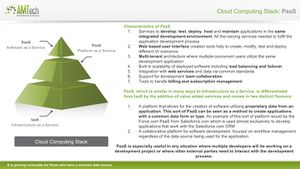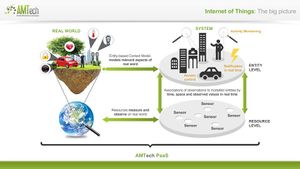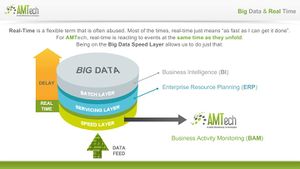Difference between revisions of "AMTech"
| Line 3: | Line 3: | ||
PaaS can be defined as a computing platform that allows the creation of web applications quickly and easily and without the complexity of buying and maintaining the software and infrastructure underneath it. | PaaS can be defined as a computing platform that allows the creation of web applications quickly and easily and without the complexity of buying and maintaining the software and infrastructure underneath it. | ||
PaaS is analogous to SaaS except that, rather than being software delivered over the web, it is a platform for the creation of software, delivered over the web. | PaaS is analogous to SaaS except that, rather than being software delivered over the web, it is a platform for the creation of software, delivered over the web. | ||
| + | [[File:AMTech PaaS.jpg|thumbnail|center|PaaS]] | ||
== Thing == | == Thing == | ||
A Thing is a physical object or even a piece of data, with a unique identifier and a group of properties like: location, temperature, speed, acceleration, altitude, weight, volume, pressure, value or any other variable that can be measured | A Thing is a physical object or even a piece of data, with a unique identifier and a group of properties like: location, temperature, speed, acceleration, altitude, weight, volume, pressure, value or any other variable that can be measured | ||
== IoT == | == IoT == | ||
The Internet of Things (IoT) is the network of physical objects (things) with unique identifiers and the ability to communicate and sense, as well as interact with their internal states and/or the external environment, without requiring human-to-human or human-to-computer interaction, by leveraging the Internet. | The Internet of Things (IoT) is the network of physical objects (things) with unique identifiers and the ability to communicate and sense, as well as interact with their internal states and/or the external environment, without requiring human-to-human or human-to-computer interaction, by leveraging the Internet. | ||
| + | [[File:IoTBP.jpg|thumbnail|center|Internet of Things]] | ||
== Big Data & Real time == | == Big Data & Real time == | ||
| + | [[File:Big-Data.jpg|thumbnail|center|Big Data * IoT]] | ||
Revision as of 12:32, 30 April 2016
Contents
PaaS
Platform as a Service (PaaS) brings the benefits that SaaS bought for applications, but over to the software development world. PaaS can be defined as a computing platform that allows the creation of web applications quickly and easily and without the complexity of buying and maintaining the software and infrastructure underneath it. PaaS is analogous to SaaS except that, rather than being software delivered over the web, it is a platform for the creation of software, delivered over the web.
Thing
A Thing is a physical object or even a piece of data, with a unique identifier and a group of properties like: location, temperature, speed, acceleration, altitude, weight, volume, pressure, value or any other variable that can be measured
IoT
The Internet of Things (IoT) is the network of physical objects (things) with unique identifiers and the ability to communicate and sense, as well as interact with their internal states and/or the external environment, without requiring human-to-human or human-to-computer interaction, by leveraging the Internet.


